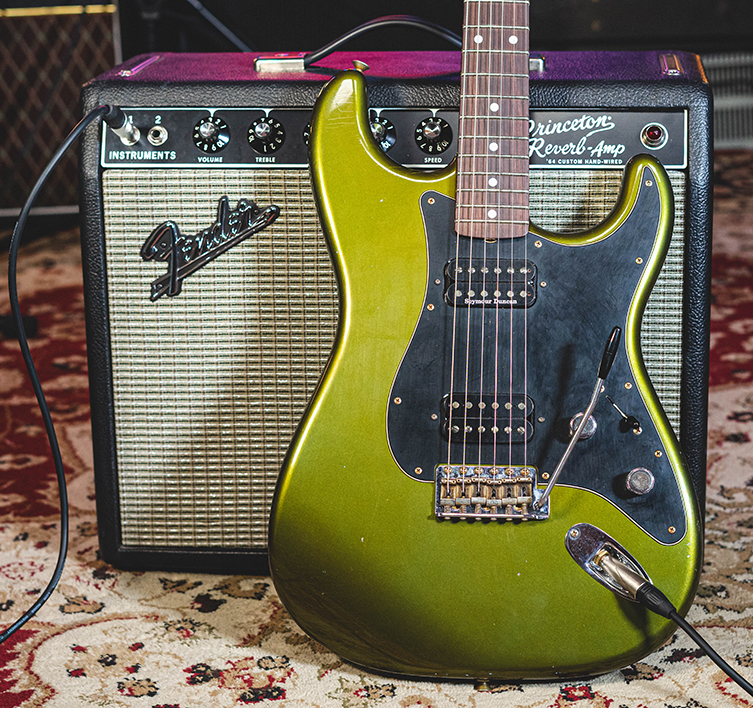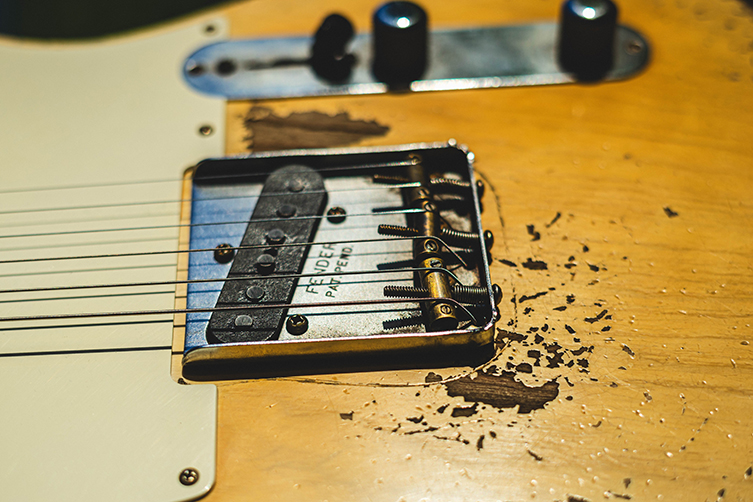If you’re looking for a pre-owned guitar to buy, you’ll know that it’s not as easy as simply finding one that you like and paying for it. Used guitars can be a fun and exciting way to both save money and attain something that’s not necessarily readily available. Searching for that lost gem from the past - or just having a general scan until something catches your eye - has always been a part of the guitarist’s lifestyle.
Because of this, we at guitarguitar take our preowned guitar buying and selling very seriously. We check and check to make sure that what we take in to sell as preowned gear is authentic and playable. Buying a preowned guitar with us also gets you benefits like a warranty on top of that aforementioned assessment. As always, we want you to leave pleased!

But that’s just guitarguitar. We can’t really speak for anyone else, and so I’ve put together a brief blog for you today, to offer some general guidance. Nothing beats pure knowledge, so if you find something you like the look of, do your research and ask plenty of questions. It’s down to you at the end of the day! But by having a read of this blog, you’ll be able to check for certain things, keep an eye out for other things, and to not worry about certain other things!
Have a read, and arm yourself with some solid knowledge right now.
Contents
NOTE: Unusual Specifications and Replacement Parts
Replacement Necks and Electronics
The Blink Test
A few years ago, I read Malcolm Gladwell’s book The Blink Test. It’s basically about how, when you look at an object (say, a sculpture, or a guitar) with a learned/trained eye, you can and often should trust your first instinct about whether it’s genuine or fake.
The idea is that you’ve looked at the same or similar objects for so long that your brain will notice an element that’s somehow out of whack: a logo is a little bit large, or the treble cutaway is a slightly strange shape. It could be a tiny thing, but these tiny things are important tells. If I were you, I’d keep this in mind when assessing used gear, and at least listen to your own inner voice. If you aren’t particularly knowledgeable about a guitar, make a note of whatever piqued your attention, then go and research it.
It is not always right, but it is so often right that it’s almost overwhelming. And I know this from years of first-hand experience. Trust that small voice!
Spotting a Fake
- Compare to trusted examples
- Look at the obvious things: decals, logo position, misaligned hardware
In this Chibson-infested world, it can sometimes feel really difficult to spot fakes, particularly from a distance online. Whatever the brand, there are things you can know and do to help you spot a fake guitar.
Logos
- Is the logo grabbing your attention? Why is that? Look closely and ask yourself the following:
- Is it too big?
- Too close to the top/edge of the headstock?
- Off-centre?
- Too spread apart? (Fender use multiple decals on headstocks: pay close attention to where they normally ought to be)
- All of these could be problems, though Fender in particular have a huge variety of logo positions and styles, so make sure you know your eras and models (particularly Telecasters).
Serial Numbers
- Serial number: if it doesn’t have one, do not buy the guitar. It’s that simple. Can you imagine selling it on yourself, and when somebody asks why there’s no serial number, you can only reply “...I don’t really know”. Lame. If the guitar hasn’t got a serial number on it, don’t make that guitar your problem.
- If it does have a serial number, then spend less than a minute online and google ‘(brand name) serial number checker’. You’ll know if you have a legit guitar very quickly.
- If it does have a serial number but the check brings up another guitar: you’ve likely got yourself a fake! Fakers repeat serial numbers often. See if the description online attached to the serial matches the guitar. Fakers often use the same serial number for hundreds of guitars.

NOTE: Unusual Specifications and Replacement Parts
- Research, research, research!
- A non-standard spec doesn’t automatically mean a fake
- All-original is more valuable by far, despite the condition
It’s trickier than ever to assess the provenance of a guitar through its specification alone. For example, Stratocasters for the last 30 years and more have been available in such a myriad of editions, limited runs and so on, that positively identifying a real one can be tricky. Serial numbers can be faked remember (see above!)
This was much less common in the past, so if you are shopping for a vintage guitar, it’s reasonably easy to research what to expect and what not to. There is a wealth of info on date specific guitars out there, so make sure you know how much neck screws there should be in a 1973 Telecaster Custom, for example (three), because the data is out there and it's on you to know it!
If somebody wants to sell you a lovely 1965 Gibson Les Paul Standard then I really want your inner alarm bells to be ringing, since 1965 Gibson Les Paul Standards have never existed. Floyd Rose tremolos on guitars from the mid-70s are NOT original! I want to sleep at night, people! Don’t do this to me!
On the other hand, things like Bigsby tremolos were often part of factory builds for Gibson, Fender and other brands (Gretsch obviously had them!), and they often weren’t necessarily part of the main production run. These guitars can often be genuine, so look for telltale signs of after-market modding to see if these are legit or not. Screw holes, missing hardware and metal parts that are tarnished in a slightly different manner (implying a different age for that part) are the main tells.
Replacement Necks and Electronics
Replacement parts are another issue to contend with. Fenders, for example, were initially designed in such a modular way (bolted-on necks, removable pickguards with circuits attached etc) in order to allow the user to simply take off worn parts and replace them with new ones. Does that then follow that an old 70s Strat with an 80s neck is not legitimate? Is it worth less?
The answers are: the guitar is absolutely legit, but cannot reasonably be called a ‘70s Strat’ any longer; and yes, it’s worth less than if it had its original neck, regardless of the condition. ‘All original parts’ is definitely a thing with collectors, and guitars with swapped-out necks and other parts suffer price-wise. If you are a player more than a collector, I don’t see that mattering much, as long as you don’t overpay for the instrument.
Replacement electronics are a very common thing for older guitars. Again, original electronics increase the value of a guitar, though in this area, it’s acceptable to have the originals in the case, and replacement electronics fitted to the guitar, as long as it is done sympathetically and non-invasively.
Finally, some modifications definitely kill the value of a guitar. In the 80s, lots of Les Paul players wanted locking tremolos on their guitars, without really thinking it through. It’s not an easy thing to take an arched top guitar with a tune-o-matic bridge and backwards-angled headstock and make a big Kahler or Floyd Rose tremolo work on it, but that didn’t stop these people from trying! These sad, butchered instruments exist, and they neither function well nor command much in the way of value. They are impossible to return to ‘normal’, and of course today you can buy a Les Paul from Epiphone or Gibson with a factory fitted Floyd Rose that does actually work! These sad specimens from the past are best avoided, regardless of the asking price. You can’t fix them!
Damage
One of the most important subjects to assess when looking at preowned instruments is damage. Damage is not always easy to spot, and in fact isn’t always visible from a casual glance. Cosmetic damage isn’t something I’ll say much about here: chips and dings are par for the course with used gear, and you can see those things easily enough from picking the guitar up and inspecting it.

What I’ll briefly highlight here are some areas that you might want to pay particular attention to, starting with necks:
Neck Damage
- On set neck guitars, have there been any breaks at the headstock? It’s relatively common, and not always easy to see. Repaired headstocks are absolutely fine to use, but they do affect the price of the guitar.
- On bolted-on guitars, look at the neck pocket. Is it a good fit? Do you see any space between neck and body?
- If you’re allowed to take the neck off, are there more screw holes than the guitar needs? How many? It’s not a problem in itself, but it is an indicator that fairly major adjustments have been made in the past, and you should ask about those.
- Does the truss rod work? It should never be a problem to test it for a ¼ or ½ a turn, particularly when you can reverse the turns very easily. Guitars with knackered truss rods are a permanent problem.
- Is the neck bowed? Is there back-bow? Both should be curable if the truss rod is okay, but extreme cases can still offer playing problems.
- Is the neck warped? Eyeball the length of the fingerboard from either the headstock end or the bridge end. If you can see a ‘tilt’ at the nut - if it isn’t straight with the bridge etc - then the neck is warped. Some call it ‘twisting’ but it’s the same thing. It’s not straight and won’t intone properly, so it’s not fit to play. Again, a truss rod tweak can often sort this out, but extreme cases can mean a write-off for the neck, or the whole instrument if it’s a set-neck.
- How are the frets? If you are a collector, you might want them to be original, regardless of how worn they are. If you plan on playing the guitar, the frets need to be in playable order, with none too worn (a crowning job could help here) or tall/out of place. Basically, anything that is preventing you from playing perfectly well is an issue, and I’d be asking why the current owner hasn’t had it fixed. Could it be that the problem isn’t fixable?
Body Damage
Thankfully, body damage is more or less obvious to spot. Again, I don’t think I need to remark on the scratches and knocks that happen to a used guitar: you’ll decide for yourself if a guitar’s too battered looking for you! Buckle rash and things of that nature are expected, so just assess for yourself how much you are ok with. But problems that undermine the integrity of the instrument are important to note here. Acoustic guitars are far more susceptible to body problems that electrics since they are thin and hollow, but these following tips should broadly be of note to all guitars:
- Deep cracks in the body are a big issue.
- Repaired deep cracks in the body are often structurally sound, but affect the value of a guitar. Some repaired cracks can affect the tone of acoustic guitars, though most actually don’t. Play the guitar and listen to how it sounds, as you normally would anyway.
- Are there any cracks around the neck joint? Some are simply lacquer cracks (not a structural problem), whilst others are cracks in the wood.
- Is the bridge lifting up from the body? Is it loose in any way?
- Has the top suffered from humidity? Run your hand across the top and see if it picks up any bumps.
- Is the top separating from the body?

Damage to the Electrics
Plug in the guitar, be it electric or electro-acoustic, and look out for the following:
- Scratchy noise when adjusting controls: easy to fix, mostly, with a quick spray of Servisol.
- Non-responsive controls: faulty!
- Dead spots in the signal when you adjust controls: faulty!
- A rattling sound coming from inside the guitar: when is that ever good? Investigate! Acoustic guitars can sometimes just have inner wires hitting off the body, but it’ll still annoy you.
- Loose input jack: normally a simple matter of hand-tightening, but do be careful that you aren’t twisting round the inner electronics, because that can lead to issues later on.
- Sound cuts out or no sound at all: grab another instrument cable and try again. Same result? Faulty!
- Does the guitar require a battery? Don’t laugh: it’s INCREDIBLE how many people don’t check or just don’t know. We’ve all been beginners once, and it’s an easy mistake to make.
Hardware Damage
Hardware damage should be pretty obvious, too. This is a mixture of visually checking and then briefly testing elements. Here’s a few bits to keep in mind:
- Are the tuners all turning fine? Try them out!
- A badly cut nut will cause you lots of problems, but I wouldn’t call this ‘damage’ per se. Just change it for a Tusq one if it’s rubbish.
- Is the bridge sitting at a strange angle? If it’s a locking type, like a Floyd Rose, then this could be causing the guitar bigger problems. In the shop, we’d often see what we called ‘Titanic tremolos’, where the bridge unit stood up so far from the body that it looked like a sinking ship. The strings were inches off the body. It’s fixable of course, but that level of extra tension is bad for the neck, the bridge itself and the body wood around the bridge. If it’s been left like that for a long time, it could’ve caused actual damage.
- Is anything loose? Can it be tightened? If so, tighten it. Is the problem solved? Don’t assume that everything can be fixed: try to see that it actually gets fixed before you pay for it.
- Is the bridge missing any parts? Don’t assume they’ll be easy to replace.
Arm Yourself With Knowledge
I think that’s all of the major things to look out for when assessing a preowned guitar. Much of it is common sense, really, but the whole fake/genuine situation is something you’ll have to just do your due diligence with. Research!
For that reason, I’d advise you not to ever feel pressured into buying a used guitar. If you feel unsure, walk away and at least have a think. If the seller is legit, they’ll have no problem with that. Come back after you’ve researched the guitar and made your mind up.
My last piece of advice for you is simple but oh-so true: If it seems too good to be true, then it is too good to be true. Nobody is selling a real 52 Tele for £800. They just aren’t, whatever the accompanying story may be. It’s easy to let our passion run away with our common sense when it comes to lovely things like guitars, but keeping your wits about you will prove to be worth it in the second-hand market.
Above all, have fun, get excited, enjoy the process but do your homework and don’t be afraid to walk away from a sale that doesn’t feel right. I hope some of the info contained in today’s guide has provided you with some tools to use in the future,and hopefully some confidence about approaching the used market. Good luck!
Click to Browse our Preowned Guitars and Equipment

